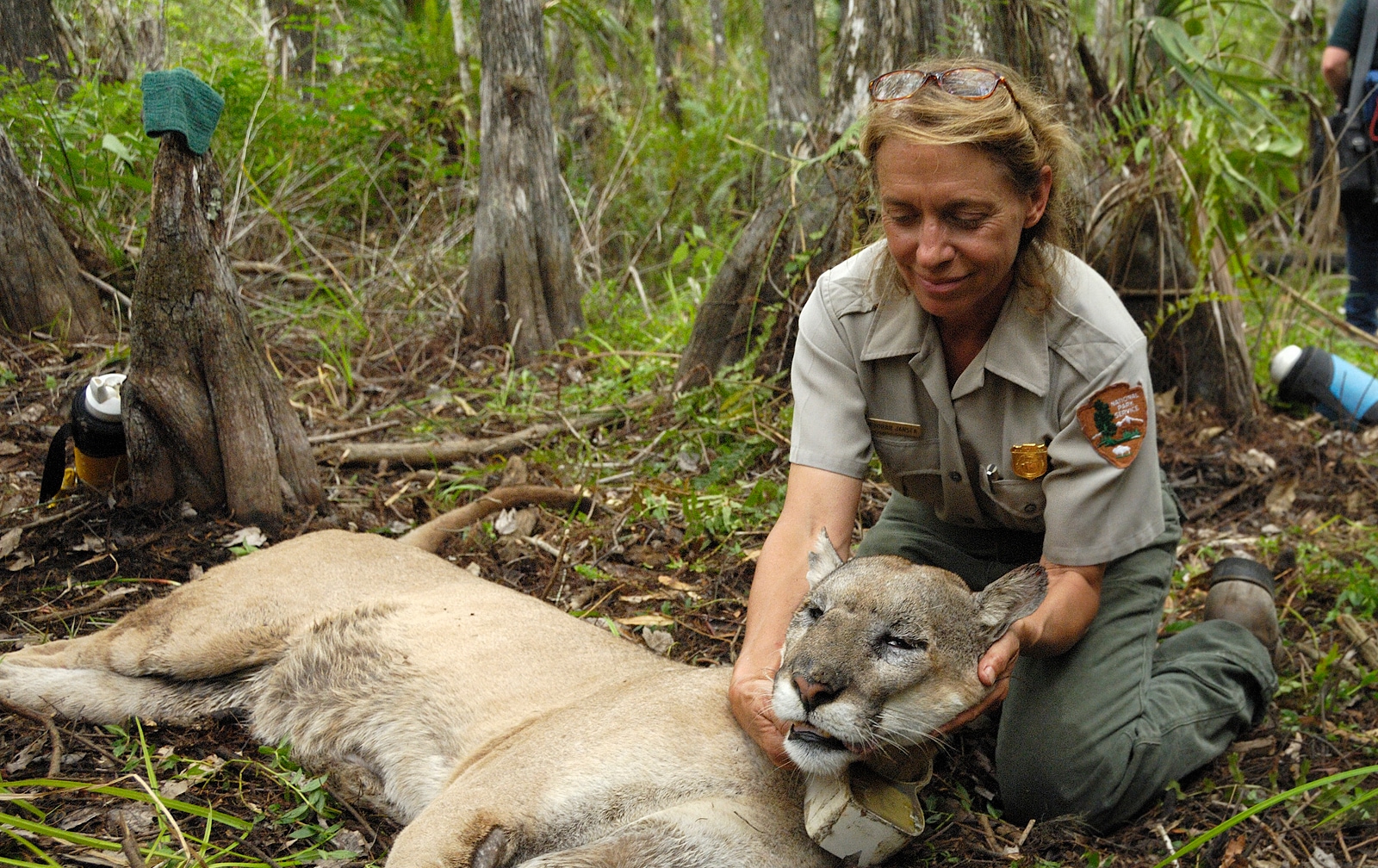For three decades, wildlife biologist Deborah Jansen has been advocating for the Florida panther, and her voice has carried much weight, despite often being the only female one in the room.
I’m starting to get a little bit worried. A lightning storm is encroaching from the east. As the first raindrops plink down, the flashes and rumbles arrive at shorter intervals. Surrounded by knee-high sawgrass in Florida’s Big Cypress Swamp, we’re like giant, humanoid lightning rods. Cover. We need to find cover, I think.
Deborah Jansen, however, looks as if she’s been in this exact situation 1,000 times—probably because she has. While my blood pressure steadily rises, Jansen, a wildlife biologist for Big Cypress National Preserve, casually steers us toward a stand of cabbage palms.
“I think there’s a den right behind us.” Taking cover in a panther den seems, at least to me, like a less-than-ideal idea.
We reach the trees right as the storm parks overhead. Raindrops spill off our hat brims and roll down the backs of our shirts. Between bellows of thunder, Jansen says, “I think there’s a den right behind us.” Taking cover in a panther den seems, at least to me, like a less-than-ideal idea. It feels a bit like asking a shark to tow you out of a rip current—it’s a solution, but it seems like a fraught one.
Tired of waiting out the lightning, she rises and starts picking her way through a tangle of brambles, methodically untangling them the way a climber might untangle a mess of rope. Finally, she bursts through it, and the branches snap shut behind her. Do I need to follow her to do justice to this story? I wonder. Can I just yell questions from here?
I’m supposed to be writing about the plight of the Florida panther, the critically endangered big cats that call this swamp home. Jansen’s work as a biologist focuses on the panther, and she’d promised to take me to see a few nesting sites. But 16 steps off the road and into the swamp, I’d realized that, while the cats were interesting, Jansen was the real story.
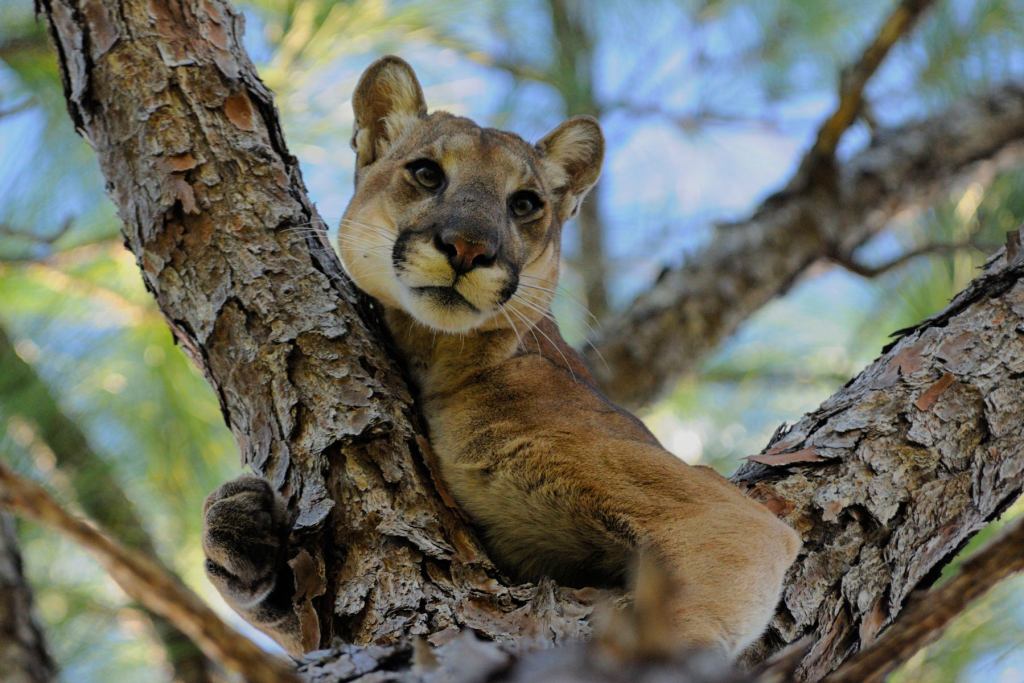
Florida panther | Photo: Ralph Arwood
In 1980, Jansen arrived in the Florida Everglades fresh out of graduate school, ready to put her degree to work. At the time, female wildlife biologists working in the field were rare. “I was one of two women in the graduate program at the University of Wisconsin-Stevens Point. Most women wildlife biologists were still expected to do office work with little field work included,” she says.
But being out in the wild was why Jansen wanted to be a biologist; she’d been stuffing snails and frogs into her pockets since she was a kid. So she passed on a few office gigs in hopes of finding work outside a cubical. Finally, Everglades National Park called.
In her first year on the job, she remembers only encountering one other woman working in the field. But that didn’t faze her. Neither did the fact that the Everglades, in the 1980s, were a raucous and wild place. Drug runners regularly pierced the waterways, moving contraband into and out of the U.S.
“I don’t really have very many fears in my life at all—and I’m never afraid of animals.”
Oh, and her assignment at Everglades National Park was a doozie: Jansen captured tagged and re-released American crocodiles for a survey project. “We’d go out at night and use a noose to catch them,” she said. Regarding American crocodiles: “They’re much more docile than alligators,” as if that somehow makes this job seem less insane.
“Weren’t you afraid?” I kept asking with every new detail she’d share, as we slogged through knee-high water. I, personally, was working hard not to think about the creatures that dwelled in the swamp’s dank understory. “I’ve never really been afraid,” she replied. “I don’t really have very many fears in my life at all,” she added, “and I’m never afraid of animals. However, I respect them as wild creatures.”
This is one of those claims that, as a journalist, I’m obligated to investigate. I’m a naturally fearful person, with a mind pre-programmed to skip directly to the worst possible outcome in any scenario. To have no fear of power-slamming a crocodile by the light of a flashlight in a pitching boat? That is unfathomable to me.
But one of her former employees, John Kellam, who now works for the Bureau of Land Management, confirmed that Jansen was indeed telling the truth. “Deb is fearless,” he said, “and I never saw her let heat, rain, high winds, lightning, deep water, alligators, bugs, dense vegetation, heights, or long hours get in the way of helping wildlife or meeting fieldwork objectives. Even under the most dire field conditions or situations, Deb always had a great attitude, and would bring delicious snacks to share and say, ‘Good food never made a bad situation worse!’”
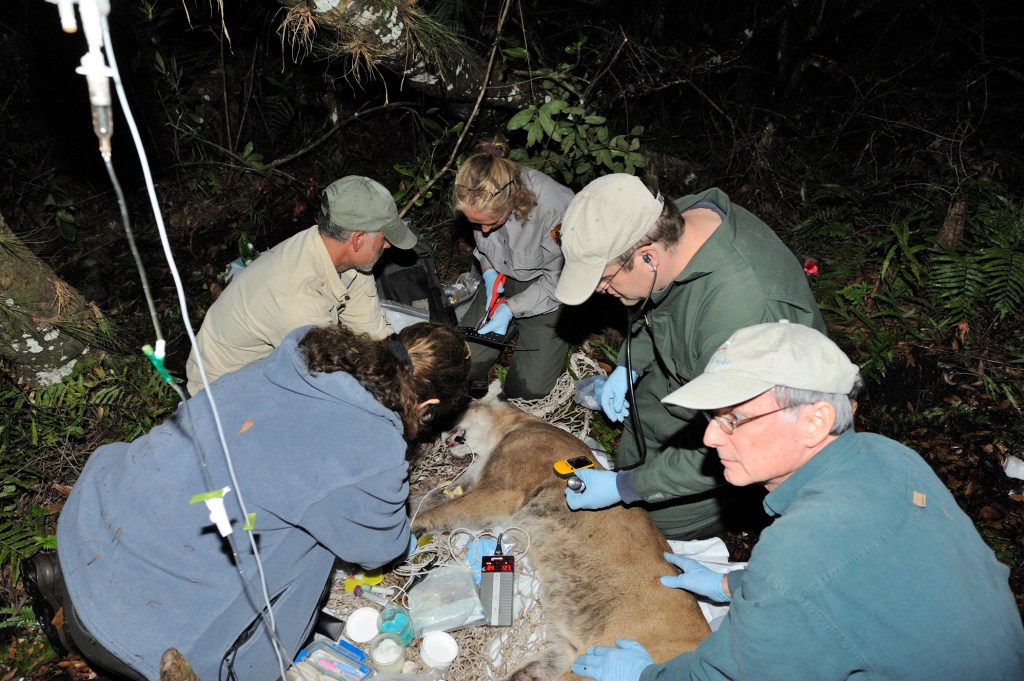
A panther capture site | Photo: Ralph Arwood
Back in the swamp, I decide I must push through the brambles (also, maybe Jansen has snacks on that side?). I finally emerge, clothes mangled, swearing a blue streak. But Jansen doesn’t notice; she’s poking at animal remains, analyzing exactly how long the panther’s kill has been dead. “Do you think it’s hungry again?” I ask, meaning more, “do you think it might like the taste of a blonde reporter?”
But Jansen misses my (semi) joke. She’s busy doing her work, which is exactly how you survive as a pioneering woman in a male-dominated field. If Jansen’ colleagues had any reservations about her abilities the week she showed up, fresh out of school and ready to wrangle alligators, her tenacious work ethic would have squashed every apprehension.
She’s hiked thousands of miles in 100-degree heat, often by herself. When the park needed someone to help with a deer survey, Jansen became the first woman to be certified in using a net gun from a helicopter.
“Deb is a very independent, persistent person who is unafraid to work hard, take on big tasks, and put up a good fight for what she believes in,” said Kellam. “Those qualities, coupled with her knowledge and passion for wildlife conservation and management enabled her to be successful in a field that has typically been dominated by men, especially early in her career.”
Plus, she will literally do anything to make sure the animals in Big Cypress National Preserve get the resources they need. She’s hiked thousands of miles in 100-degree heat, often by herself. When the park needed someone to help with a deer survey, Jansen became the first woman to be certified in using a net gun (which shoots a net over an animal) from a helicopter. Jansen has spent entire days in—and sometimes leaning out of—helicopters, and no, she’s never had a moment where she’s felt scared of that, either. Regarding being in helicopters and small planes: “I just really like to be up there, looking around,” she says like it’s the most natural thing in the world.
Her lack of fear transcends meetings, too. “I’m not afraid to be brutally honest.” She added, “I don’t play politics either.”
Yes, she was one of the first female wildlife biologists to work in the field. But that’s just a tiny sliver of what she’s accomplished.
For Jansen, what’s good for the Florida panthers is good for her, even if it ends up ruffling some feathers along the way. Recently, Jansen has been fighting to keep development of local roadways safe for the big cats. Right now, cars are one of the biggest causes of death for panthers. In 2013, 2014, and 2015, new records were set then reset in numbers of vehicle-caused panther deaths. Jansen has been lobbying for high fencing to line the main thoroughfares in panther territory, and for underpasses that allow the felines to safely cross the road. It’s an expensive endeavor, but one Jansen hasn’t been shy about promoting, even if it’s politically unpopular. “My job is to be the spokesperson for the panthers and the other wildlife.”
Sometimes, when stories like this get written, there’s a tendency to focus on the gender-bucking aspect of someone’s career. But with Jansen, that would be a mistake. Yes, she was one of the first female wildlife biologists to work in the field. But that’s just a tiny sliver of what she’s accomplished. Over the years, she’s become one of the area’s foremost panther experts and advocates. She’s also become an incredible naturalist with a deep bank of institutional knowledge on the Everglades and Big Cypress Swamp ecosystems. She notices when tiny changes happen in the swamp.
Lately, she’s been noting more cabbage palms than ever. “It’s related to the recent fires burning so hot,” she says. Hot fires burn through everything except cabbage palms, which are fire-resistant. It’s a subtle observation, but one that matters in an ecosystem as nuanced as the Big Cypress Swamp.
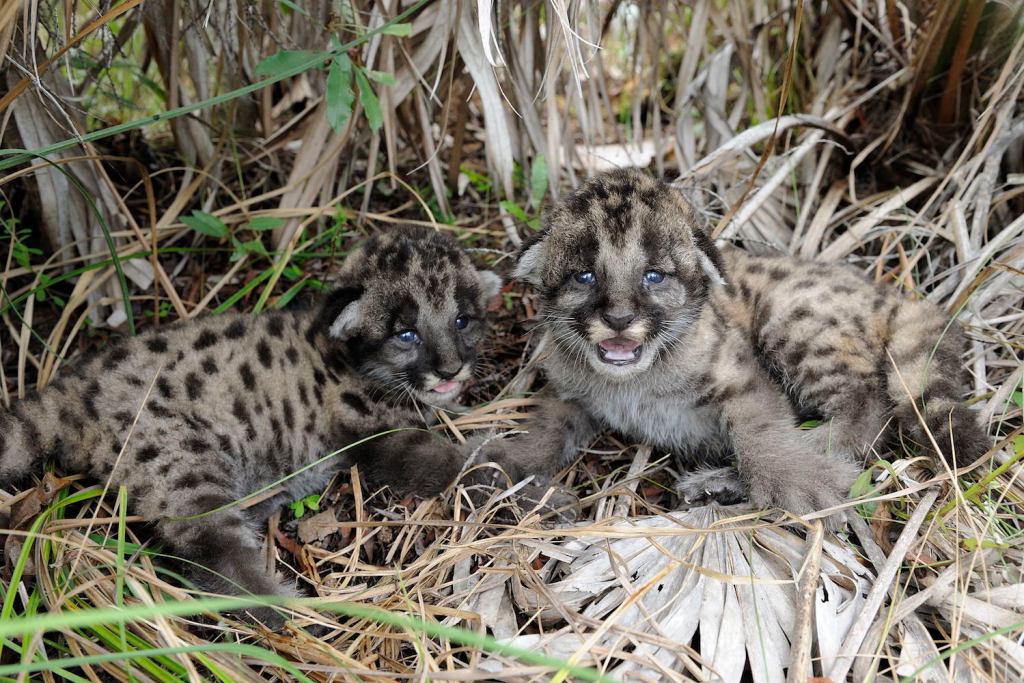
18-day-old Florida panthers | Photo: Ralph Arwood
While the Florida panthers’ future is still looking somewhat perilous—only around 150 cats remain in South Florida—things certainly are better than they were two decades ago. At one point, the panther population was so small that Texas pumas had to be brought in to keep the species (which numbered as low as 20-30 cats) from becoming a genetic cesspool. It was a contentious decision to bring in new blood, but Jansen says that years later, it’s clear it was the right one.
It would be unfair to credit Jansen with all of the success for bringing back panthers. After all, a large coalition of federal and state agencies worked together to make the rebound happen. Still, she’s been a relentless force in their recovery, eschewing comfort to spend days in the swamp tracking and notating the cats’ every habit, and showing up to argue their case at meetings.
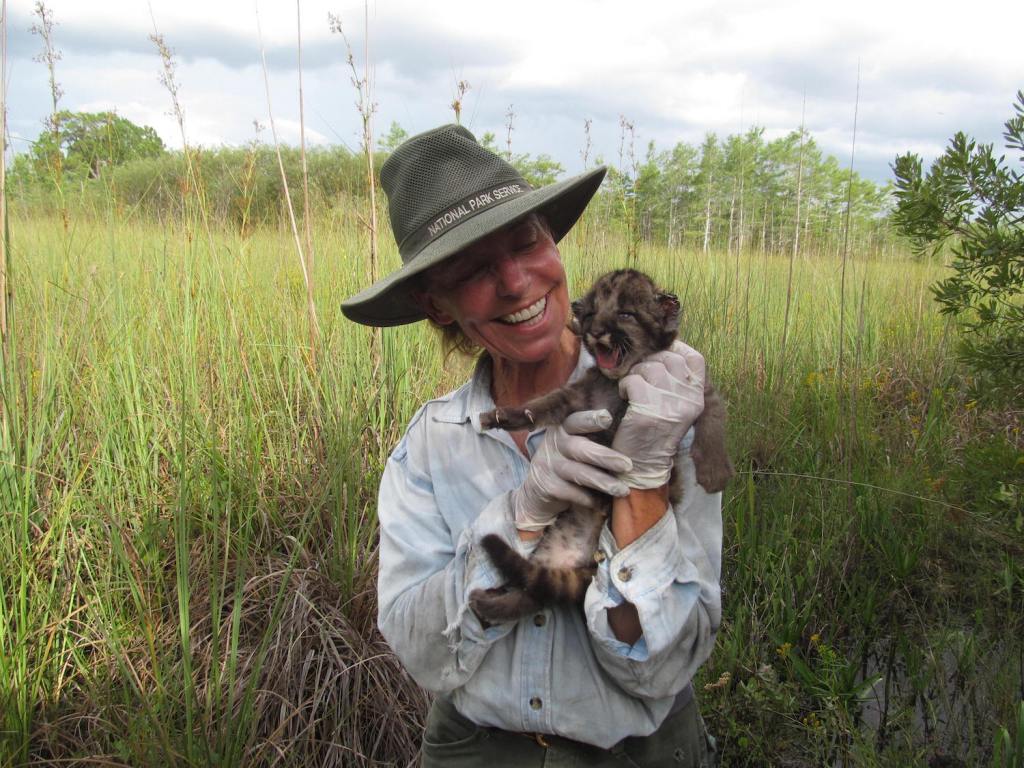
Jansen | Photo: National Park Service
As we trudge out of the den and back into the swamp, I try to match her steps, hoping it will narrow the odds of an unplanned reptilian encounter. The rain has stopped and it’s now 100 degrees. I can’t quite remember which direction the car is. But Jansen never falters. Today she is my fearless leader, but as we open the doors and climb into the truck’s steamy cab, I think of just how lucky the cats are to have her as their fearless leader every other day of the week.
